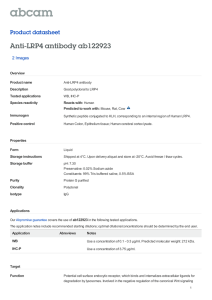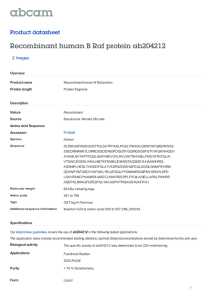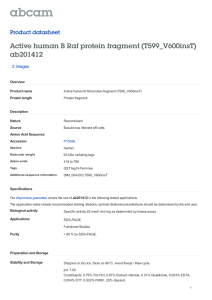Anti-Connexin 43 / GJA1 antibody ab66151 Product datasheet 1 Abreviews 1 Image
advertisement
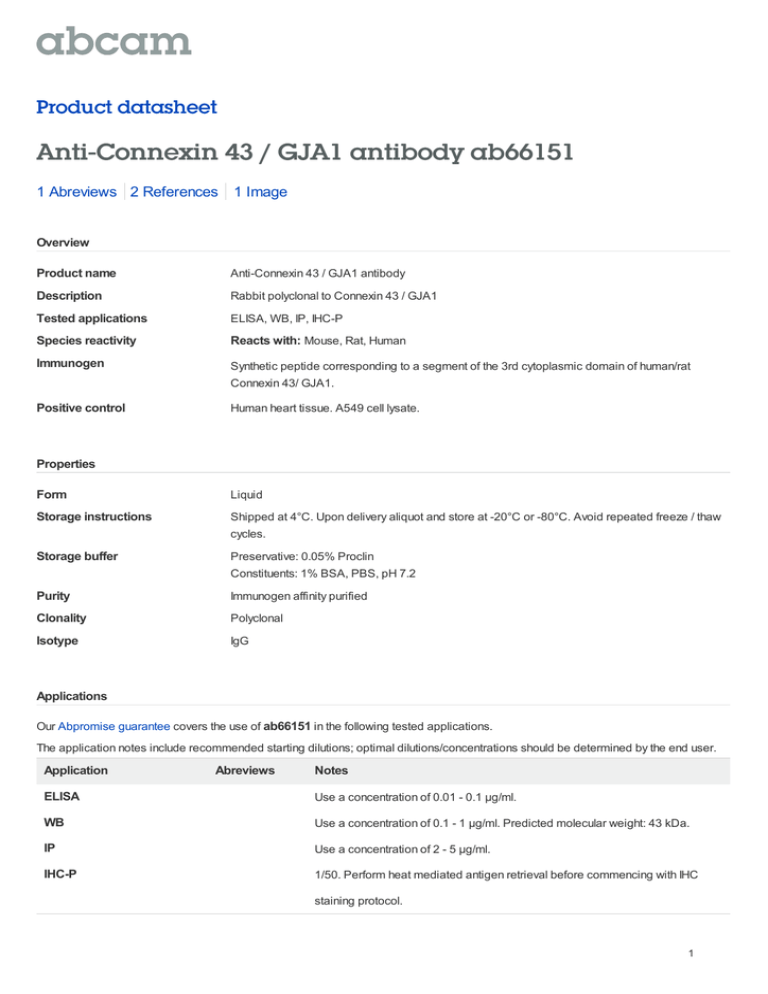
Product datasheet Anti-Connexin 43 / GJA1 antibody ab66151 1 Abreviews 2 References 1 Image Overview Product name Anti-Connexin 43 / GJA1 antibody Description Rabbit polyclonal to Connexin 43 / GJA1 Tested applications ELISA, WB, IP, IHC-P Species reactivity Reacts with: Mouse, Rat, Human Immunogen Synthetic peptide corresponding to a segment of the 3rd cytoplasmic domain of human/rat Connexin 43/ GJA1. Positive control Human heart tissue. A549 cell lysate. Properties Form Liquid Storage instructions Shipped at 4°C. Upon delivery aliquot and store at -20°C or -80°C. Avoid repeated freeze / thaw cycles. Storage buffer Preservative: 0.05% Proclin Constituents: 1% BSA, PBS, pH 7.2 Purity Immunogen affinity purified Clonality Polyclonal Isotype IgG Applications Our Abpromise guarantee covers the use of ab66151 in the following tested applications. The application notes include recommended starting dilutions; optimal dilutions/concentrations should be determined by the end user. Application Abreviews Notes ELISA Use a concentration of 0.01 - 0.1 µg/ml. WB Use a concentration of 0.1 - 1 µg/ml. Predicted molecular weight: 43 kDa. IP Use a concentration of 2 - 5 µg/ml. IHC-P 1/50. Perform heat mediated antigen retrieval before commencing with IHC staining protocol. 1 Target Function One gap junction consists of a cluster of closely packed pairs of transmembrane channels, the connexons, through which materials of low MW diffuse from one cell to a neighboring cell. May play a critical role in the physiology of hearing by participating in the recycling of potassium to the cochlear endolymph. Tissue specificity Expressed in the heart and fetal cochlea. Involvement in disease Defects in GJA1 are the cause of autosomal dominant oculodentodigital dysplasia (ODDD) [MIM:164200]; also known as oculodentoosseous dysplasia. ODDD is a highly penetrant syndrome presenting with craniofacial (ocular, nasal, dental) and limb dysmorphisms, spastic paraplegia, and neurodegeneration. Craniofacial anomalies tipically include a thin nose with hypoplastic alae nasi, small anteverted nares, prominent columnella, and microcephaly. Brittle nails and hair abnormalities of hypotrichosis and slow growth are present. Ocular defects include microphthalmia, microcornea, cataracts, glaucoma, and optic atrophy. Syndactyly type 3 and conductive deafness can occur in some cases. Cardiac abnormalities are observed in rare instances. Defects in GJA1 are the cause of autosomal recessive oculodentodigital dysplasia (ODDD autosomal recessive) [MIM:257850]. Defects in GJA1 may be the cause of syndactyly type 3 (SDTY3) [MIM:186100]. Syndactyly is an autosomal dominant trait and is the most common congenital anomaly of the hand or foot. It is marked by persistence of the webbing between adjacent digits, so they are more or less completely attached. In this type there is usually complete and bilateral syndactyly between the fourth and fifth fingers. Usually it is soft tissue syndactyly but occasionally the distal phalanges are fused. The fifth finger is short with absent or rudimentary middle phalanx. The feet are not affected. Defects in GJA1 are a cause of hypoplastic left heart syndrome (HLHS) [MIM:241550]. HLHS refers to the abnormal development of the left-sided cardiac structures, resulting in obstruction to blood flow from the left ventricular outflow tract. In addition, the syndrome includes underdevelopment of the left ventricle, aorta, and aortic arch, as well as mitral atresia or stenosis. Defects in GJA1 are a cause of Hallermann-Streiff syndrome (HSS) [MIM:234100]. HSS is a disorder characterized by a typical skull shape (brachycephaly with frontal bossing), hypotrichosis, microphthalmia, cataracts, beaked nose, micrognathia, skin atrophy, dental anomalies and proportionate short stature. Mental retardation is present in a minority of cases. Sequence similarities Belongs to the connexin family. Alpha-type (group II) subfamily. Cellular localization Cell membrane. Cell junction > gap junction. Anti-Connexin 43 / GJA1 antibody images 2 ab66151, at 1/50 dilution, staining Connexin 43 / GJA1 in human heart tissue by immunohistochemistry. Immunohistochemistry (Formalin/PFA-fixed paraffin-embedded sections) - Connexin 43 / GJA1 antibody (ab66151) Please note: All products are "FOR RESEARCH USE ONLY AND ARE NOT INTENDED FOR DIAGNOSTIC OR THERAPEUTIC USE" Our Abpromise to you: Quality guaranteed and expert technical support Replacement or refund for products not performing as stated on the datasheet Valid for 12 months from date of delivery Response to your inquiry within 24 hours We provide support in Chinese, English, French, German, Japanese and Spanish Extensive multi-media technical resources to help you We investigate all quality concerns to ensure our products perform to the highest standards If the product does not perform as described on this datasheet, we will offer a refund or replacement. For full details of the Abpromise, please visit http://www.abcam.com/abpromise or contact our technical team. Terms and conditions Guarantee only valid for products bought direct from Abcam or one of our authorized distributors 3
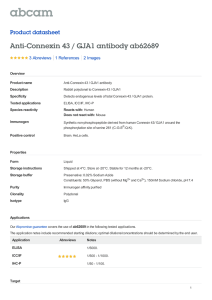
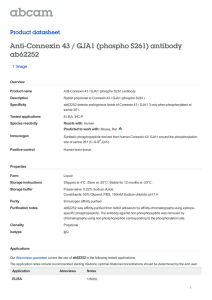
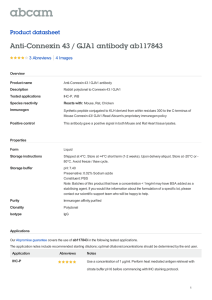
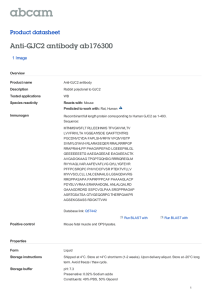
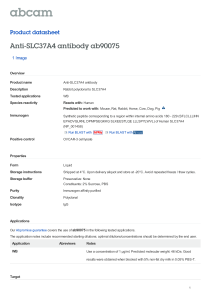
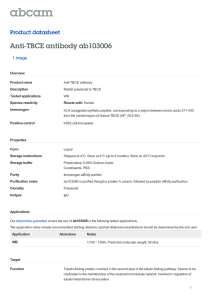
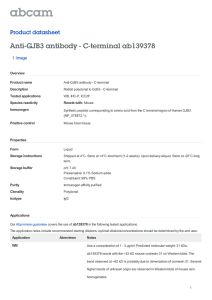
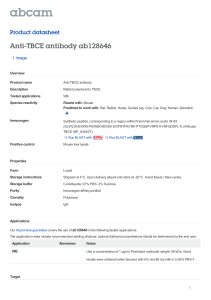
![Anti-IL17C antibody [MM0375-9P31] ab90941 Product datasheet Overview Product name](http://s2.studylib.net/store/data/012448290_1-014cf236df03924b6ad1d746bdc76800-300x300.png)
